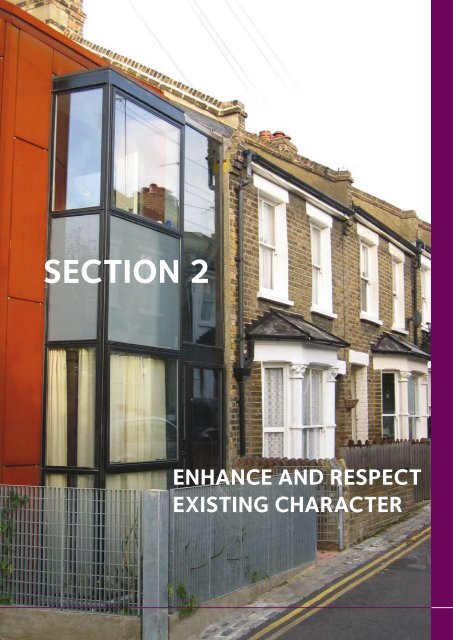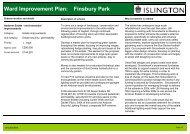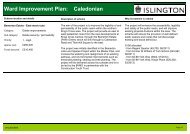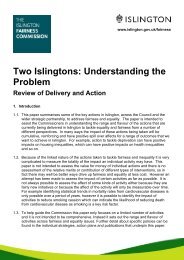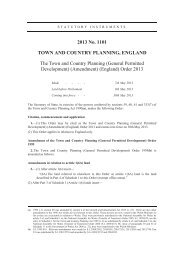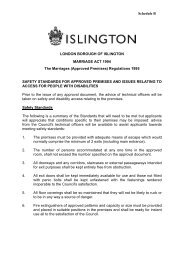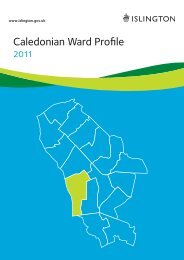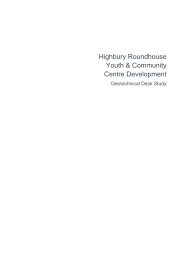Urban Design Guide - Section 2 Enhance and ... - Islington Council
Urban Design Guide - Section 2 Enhance and ... - Islington Council
Urban Design Guide - Section 2 Enhance and ... - Islington Council
Create successful ePaper yourself
Turn your PDF publications into a flip-book with our unique Google optimized e-Paper software.
SECTION 2<br />
ENHANCE AND RESPECT<br />
EXISTING CHARACTER
2.1 CONTEXT AND LOCAL DISTINCTIVENESS<br />
Highbury Place – new houses have been<br />
adjoined to the grade 2 listed Georgian<br />
terrace <strong>and</strong> created compositional unity by<br />
careful replication of the proportions <strong>and</strong><br />
details of the existing buildings.<br />
On the right is a fine example of a<br />
contemporary terrace that fits harmoniously<br />
opposite an Edwardian terrace of similar scale<br />
<strong>and</strong> proportions.<br />
2.1 Context And Local<br />
Distinctiveness<br />
Much of <strong>Islington</strong> benefits from a rich streetbased<br />
urban fabric both inside <strong>and</strong> outside<br />
conservation areas. New buildings should<br />
reinforce this character by creating an<br />
appropriate <strong>and</strong> durable fit that harmonise<br />
with their setting. They should create a scale<br />
<strong>and</strong> form of development that is appropriate<br />
in relation to the existing built form so that it<br />
provides a consistent / coherent setting for<br />
the space or street that it defines or encloses,<br />
while also enhancing <strong>and</strong> complementing the<br />
local identity of an area.<br />
The nature of the existing street frontage will<br />
therefore normally determine the extent of<br />
potential development.<br />
“The character of townscape depends<br />
on how individual buildings contribute to<br />
a harmonious whole, through relating to<br />
the scale of their neighbours <strong>and</strong> creating<br />
a continuous urban form”. (DETR - ‘By<br />
<strong>Design</strong>’, p21)<br />
Within this context, high quality<br />
contemporary designs will be supported,<br />
except in uniform terraces where exact<br />
replication may be required for the sake of<br />
compositional unity. Contemporary designs<br />
can be used in historically sensitive areas<br />
– nevertheless extra care needs to be taken:<br />
the scheme should be of an extremely<br />
high st<strong>and</strong>ard <strong>and</strong> designed from a strong<br />
underst<strong>and</strong>ing of the surrounding context.<br />
Pastiche design that is a poor copy of the<br />
original design will generally be resisted.<br />
“New <strong>and</strong> old buildings can coexist happily<br />
without disguising one as the other, if the<br />
design of the new is a response to urban<br />
design objectives”. (DETR - ‘By <strong>Design</strong>’,<br />
p19)<br />
All new buildings will need to respond<br />
appropriately to the existing frontage <strong>and</strong><br />
normally follow the established building line<br />
18 <strong>Islington</strong> <strong>Urban</strong> <strong>Design</strong> <strong>Guide</strong> December 2006
(refer to section 3.2 – Building Lines). In areas<br />
that have lost their original street pattern <strong>and</strong><br />
character, street based redevelopment will<br />
often be required to knit the area back with<br />
the surrounding street pattern.<br />
Buildings that st<strong>and</strong> out because they fail to<br />
conform with these st<strong>and</strong>ards will only be<br />
acceptable in exceptional circumstances (refer<br />
to 1.1.2, 2.2.3 <strong>and</strong> 3.2.5).<br />
“A building should only st<strong>and</strong> out from<br />
the background of buildings if it<br />
contributes positively to views <strong>and</strong><br />
vistas as a l<strong>and</strong>mark. Buildings which<br />
have functions of civic importance are<br />
one example”. (DETR - ‘By <strong>Design</strong>’, p21)<br />
Further detailed guidance <strong>and</strong> policy on<br />
buildings within conservation areas is<br />
provided by Conservation Area <strong>Design</strong><br />
<strong>Guide</strong>lines <strong>and</strong> section 12.3 of the UDP.<br />
Compton Rd - a Victorian terrace (left) sits<br />
opposite a weak pastiche. (right)<br />
2.1 CONTEXT AND LOCAL DISTINCTIVENESS<br />
A pastiche design that has none of the<br />
refinement of the adjacent late Victorian<br />
terrace.<br />
This infill (on the right)is not entirely faithful to<br />
the existing building but it nevertheless<br />
re-establishes the lost half of a Victorian semi<br />
detached house.<br />
<strong>Islington</strong> <strong>Urban</strong> <strong>Design</strong> <strong>Guide</strong> December 2006<br />
19
2.2 HEIGHT AND SCALE<br />
Union Chapel soars above Compton Terrace - an<br />
important <strong>and</strong> appropriate local l<strong>and</strong>mark.<br />
2.2 HEIGHT AND SCALE<br />
2.2.1 Background<br />
During the post-war period, parts of<br />
<strong>Islington</strong> like many other places in Britain<br />
suffered from unsympathetic<br />
redevelopment. The harmony, character <strong>and</strong><br />
order of the street-based environment, was<br />
undermined by uneven <strong>and</strong> comprehensive<br />
development. Nevertheless, subtle variation<br />
in height <strong>and</strong> form can sometimes add<br />
interest, particularly where it has evolved<br />
over a number of years. Before 1939 where<br />
bigger variations occurred, this appropriately<br />
reflected the relative public importance of<br />
buildings such as a church or town hall. Today,<br />
sharp differences between the scale of small<br />
buildings <strong>and</strong> large, out-of-scale monoliths<br />
have broken down the old building hierarchy,<br />
undermined the character of many areas<br />
<strong>and</strong> their sense of order. Where there is an<br />
opportunity to address this they should be<br />
corrected. The Building Heights Advice Note,<br />
nevertheless defines specific areas within<br />
the borough where buildings that exceed 30<br />
metres can be located subject to a number of<br />
criteria.<br />
2.2.2 Overall Criteria<br />
Street frontages with a consistent roofline<br />
<strong>and</strong> facades are generally sensitive to<br />
alteration <strong>and</strong> there will normally be a<br />
presumption against change (refer to section<br />
2.4). There is usually more scope for change<br />
in the roofline <strong>and</strong> facades within streets<br />
with a variety of frontages / building heights,<br />
particularly where the height of frontages is<br />
relatively low in proportion to the width of<br />
the street.<br />
This tower block has no respect for the original<br />
height, scale or street line.<br />
20<br />
<strong>Islington</strong> <strong>Urban</strong> <strong>Design</strong> <strong>Guide</strong> December 2006
This building was seamlessly extended from two to<br />
three storeys <strong>and</strong> now responds better to the scale<br />
of its immediate neighbours.<br />
An opportunity for significantly extending the<br />
height of a street frontage - a more consistent<br />
building line <strong>and</strong> the extra enclosure would help<br />
define the street.<br />
2.2 HEIGHT AND SCALE<br />
Upper Street - the subtle variation in height is given underlying order by its narrow plot widths - any change<br />
to the roofline might undermine its harmony <strong>and</strong> human scale. The N1 shopping centre (foreground) has been<br />
successfully inserted by respecting this arrangement.<br />
<strong>Islington</strong> <strong>Urban</strong> <strong>Design</strong> <strong>Guide</strong> December 2006<br />
21
2.2 HEIGHT AND SCALE<br />
A sensitive intervention that marginally rises<br />
above its neighbours at a bend in the road.<br />
Example of uneven development - this<br />
block has no respect for the height, scale<br />
or proportions of the uniform terrace or the<br />
topography.<br />
However, variations in building heights, do<br />
not in itself provide a justification for height<br />
increases. An alteration or extension to the<br />
existing roofline may still be unacceptable in<br />
the following circumstances:<br />
• Where the existing street frontages <strong>and</strong><br />
roof profile have historical <strong>and</strong> / or<br />
architectural importance <strong>and</strong> / or<br />
contribute to an area’s individual<br />
character. This will include listed buildings,<br />
conservation areas <strong>and</strong> sometimes other<br />
buildings that do not have this status.<br />
• Where the alteration to a façade or<br />
roofline impacts adversely upon the<br />
architectural integrity <strong>and</strong> quality of the<br />
existing or neighbouring buildings.<br />
• Where a change to the roofline or façade<br />
would be out of scale with its neighbours,<br />
especially if it starts to inappropriately<br />
dominate the street, <strong>and</strong> undermines the<br />
rhythm of the street frontage.<br />
• Where change adversely impacts on views<br />
<strong>and</strong> l<strong>and</strong>marks.<br />
• Where it impacts adversely on the<br />
topography of the street.<br />
• Where it causes a canyon effect <strong>and</strong> / or<br />
unduly overshadows the street.<br />
• Where it impacts adversely on the<br />
character of an open space or the public<br />
realm.<br />
• Where it creates an imbalance in height<br />
between opposite sides of the street. This<br />
may not be relevant where there is<br />
potential future scope for the<br />
redevelopment of the opposite side too,<br />
or on wide streets.<br />
The two sides of the street are unbalanced.<br />
22<br />
<strong>Islington</strong> <strong>Urban</strong> <strong>Design</strong> <strong>Guide</strong> December 2006
2.2.3 Views <strong>and</strong> L<strong>and</strong>marks<br />
General Principles<br />
The scope for high buildings including<br />
buildings that rise above 30 metres <strong>and</strong> larger<br />
street frontages are covered in the Building<br />
Heights Advice Note. The IUDG deals with<br />
general principles <strong>and</strong> st<strong>and</strong>ards.<br />
As set out in section 12.2 of the UDP, the<br />
<strong>Council</strong> will protect <strong>and</strong> enhance strategic <strong>and</strong><br />
local views of strategic <strong>and</strong> local l<strong>and</strong>marks.<br />
Any building which blocks or detracts from<br />
important or potentially important views, will<br />
be resisted.<br />
Notwithst<strong>and</strong>ing the above, a building<br />
that st<strong>and</strong>s out can sometimes contribute<br />
positively to the urban environment by:<br />
• Becoming a focal point.<br />
• Providing an element of surprise or<br />
contrast.<br />
• Reinforcing a sense of place.<br />
• Highlighting the importance of a public<br />
building.<br />
This may provide a justification for a building<br />
that, contrasts with its neighbours or, more<br />
occasionally, rises above its neighbours.<br />
It will nevertheless need to be a special<br />
building that is suitably located <strong>and</strong> designed<br />
to an exceptional st<strong>and</strong>ard that embodies<br />
an integrity that is carried through all its<br />
elevations. It must also respond to its<br />
surrounding threshold (refer to section 3).<br />
The Union Chapel’s dominance is undermined<br />
by a nearby residential tower block.<br />
<strong>Islington</strong>’s most recent major l<strong>and</strong>mark.<br />
2.2 HEIGHT AND SCALE<br />
St James Church carefully framed by the<br />
buildings that front Clerkenwell Green.<br />
<strong>Islington</strong> <strong>Urban</strong> <strong>Design</strong> <strong>Guide</strong> December 2006<br />
23
2.2 HEIGHT AND SCALE<br />
The verticality of a corner can be exaggerated<br />
without reliance on extra height.<br />
Great care needs to be taken with the design<br />
of corners. The impact of a poorly designed<br />
or detailed elevation becomes magnified on<br />
corners particularly if it is designed to be<br />
emphasised.<br />
Buildings do not have to be big to st<strong>and</strong> out.<br />
Corners are often best addressed by<br />
creative articulation rather than any<br />
height increase.<br />
24<br />
<strong>Islington</strong> <strong>Urban</strong> <strong>Design</strong> <strong>Guide</strong> December 2006
Emphasising Junctions<br />
It is sometimes appropriate to have a focal<br />
point that announces or reinforces a place<br />
or closes a view. Closing a view at the<br />
junction of streets can heighten the role of<br />
architecture in giving character to space <strong>and</strong><br />
provide an element of anticipation.<br />
It is often appropriate to emphasise a corner,<br />
particularly at an important junction. This is<br />
usually best achieved by exaggerating the<br />
vertical proportions of a façade through<br />
clever articulating devices, for example by:<br />
2.2 HEIGHT AND SCALE<br />
• Curving the frontage.<br />
• Wrapping the fenestration around the<br />
corner.<br />
• Terminating the roof differently.<br />
It is sometimes appropriate to provide<br />
further punctuation by raising the height of<br />
the corner marginally above the prevailing<br />
height to reinforce the importance of a<br />
junction. Where extra height is proposed it<br />
should be contained so that it does not spill<br />
further down the street frontage, otherwise<br />
the punctuation will become diluted <strong>and</strong><br />
the coherence of the rest of the frontage<br />
undermined; in other words the punctuation<br />
of the junction should be a ‘full stop’ <strong>and</strong> not<br />
‘part of the sentence’.<br />
1 City Road occupies a prominent corner.<br />
As well as closing the view, it also lines up<br />
with the centre line of Moorgate for which it<br />
provides a defining l<strong>and</strong>mark.<br />
© Crown copyright. All rights reserved. London Borough of <strong>Islington</strong> LA100021551 2007.<br />
<strong>Islington</strong> <strong>Urban</strong> <strong>Design</strong> <strong>Guide</strong> December 2006<br />
25
2.2 HEIGHT AND SCALE<br />
Consistent height <strong>and</strong> building form <strong>and</strong><br />
height on both sides of a new street<br />
provides balance <strong>and</strong> a good consistent<br />
backdrop that gives the street coherence<br />
<strong>and</strong> an appropriate sense of enclosure.<br />
2.2.4 Comprehensive<br />
Redevelopment<br />
On a large site where there is an opportunity<br />
for comprehensive redevelopment with<br />
new streets <strong>and</strong> spaces created, there may<br />
be scope to incorporate street frontages,<br />
within the centre of the development that<br />
are marginally higher than the existing area.<br />
Where the new development meets existing<br />
streets or street frontages it will still normally<br />
need to conform with the height of the<br />
neighbouring or adjoining terrace <strong>and</strong> will<br />
therefore need to be considered in terms of<br />
the above criteria in section 2.2.<br />
New schemes often work most satisfactorily<br />
where the height <strong>and</strong> building form is<br />
consistent along each new street frontage,<br />
so that they read in terms of the rhythm<br />
of the frontage <strong>and</strong> as a backdrop to the<br />
space or street they define, <strong>and</strong> do not draw<br />
too much attention. A variation of building<br />
height can contribute towards a fragmented<br />
environment. Most notably when individual<br />
buildings inappropriately dominate, or are<br />
too monolithic in appearance, such as that<br />
occurred in many 1960’s developments.<br />
(Refer also to 3.2.4 Practical Application of<br />
the Perimeter Block Layout).<br />
Parts of <strong>Islington</strong> have suffered from<br />
uneven <strong>and</strong> fragmented development that<br />
undermines the coherence of the spaces<br />
between buildings.<br />
A variation of buildings<br />
can contribute towards a<br />
fragmented environment,<br />
particularly when individual<br />
buildings inappropriately<br />
dominate or are too<br />
monolithic in appearance,<br />
such as occurred in many<br />
1960’s developments.<br />
26<br />
<strong>Islington</strong> <strong>Urban</strong> <strong>Design</strong> <strong>Guide</strong> December 2006
2.2.5 Height to Width Ratios<br />
General Principles<br />
Building height also needs to be considered in<br />
terms of its proportion in relation to the size<br />
of the space it defines / encloses. The height<br />
of a street frontage should provide sufficient<br />
sense of enclosure, natural surveillance <strong>and</strong><br />
maximise the potential development<br />
opportunity of a site.<br />
Most of <strong>Islington</strong>’s Victorian residential<br />
terraced streets have a height-to-width ratio<br />
of between 0.5 to 1 <strong>and</strong> 0.7 to 1. Streets<br />
with a ratio of between 0.5 to 1 <strong>and</strong> 1 to 1<br />
normally provide a well proportioned street<br />
frontage which provides a good sense of<br />
enclosure.<br />
2.2 HEIGHT AND SCALE<br />
Streets with Frontages that Exceed their<br />
Width<br />
Schemes where the height exceeds the<br />
width of the street will not normally be<br />
acceptable if they cause a canyon effect<br />
<strong>and</strong> inhibit sufficient light <strong>and</strong> air reaching<br />
the buildings <strong>and</strong> street below, unless they<br />
can be justified in terms of adding to local<br />
distinctiveness. Nevertheless there may be<br />
more scope on those streets with a north-tosouth<br />
orientation as they normally allow more<br />
sunlight to permeate than streets with an<br />
east-to-west axis.<br />
The height of street frontages should normally be in<br />
proportion to the width of the street they define<br />
(Image from ‘By <strong>Design</strong>’)<br />
The south of the borough, <strong>and</strong> some of the<br />
other older parts of <strong>Islington</strong>, were originally<br />
characterised by a dense network of streets<br />
<strong>and</strong> alleys where the heights of building<br />
frontages often exceeded the width. High<br />
sided frontages along comparatively narrow<br />
streets will therefore normally be acceptable<br />
where they contribute towards maintaining<br />
the existing character of the area.<br />
– Deep narrow street typical of 18th <strong>and</strong> 19thC<br />
in the south of the borough<br />
<strong>Islington</strong> <strong>Urban</strong> <strong>Design</strong> <strong>Guide</strong> December 2006<br />
27
2.2 HEIGHT AND SCALE<br />
Westbourne Rd looking south from Bride St<br />
junction - 0.7 to 1 ratio provides strong<br />
enclosure that does not undermine amenity.<br />
Westbourne Rd looking north from Bride<br />
St junction- enclosure is weakened by the<br />
wider street, squat frontages <strong>and</strong> gaps<br />
between the end on houses.<br />
Low Frontages <strong>and</strong> Wide Streets<br />
Anything less than a 0.3 to 1 height to width<br />
ratio can result in streets, which suffer from<br />
too little enclosure where the buildings appear<br />
divorced from the street. This can sometimes<br />
be justified where the immediate context is<br />
characterised by this scale of buildings, <strong>and</strong><br />
where it contributes to local distinctiveness.<br />
Additional enclosure can often be provided by<br />
trees along the kerb edge or, in front gardens.<br />
Elsewhere, low frontages may appear<br />
inappropriately suburban in scale. They also<br />
may not maximise the development potential<br />
of the site or the natural surveillance<br />
opportunities.<br />
Exaggerating <strong>and</strong> Minimising the<br />
Apparent Height<br />
Sometimes there is a need to exaggerate or<br />
minimise the apparent height of a new<br />
development so that it accords with the<br />
context of the street. There are<br />
circumstances where the scale of<br />
development proposed is too small for its<br />
context. For example, the size of the frontage<br />
can sometimes be increased by generously<br />
extending the front face of the building above<br />
the top floor.<br />
Some of <strong>Islington</strong>’s main commercial streets such as Holloway Road are considerably wider than the height of<br />
the buildings that face them which sometimes provides scope for bigger frontages.<br />
28<br />
<strong>Islington</strong> <strong>Urban</strong> <strong>Design</strong> <strong>Guide</strong> December 2006
Conversely, it can be necessary to keep the<br />
scale of the frontage to a minimum, especially<br />
along roads that are already rather narrow <strong>and</strong><br />
cavernous. This can sometimes be achieved<br />
by generously setting back the upper floors<br />
behind the front roof parapet so that it is not<br />
apparent from the street. Such a solution will<br />
also need to work in terms of its impact from<br />
longer views where it may be more visible. A<br />
ziggurat, or stepping back, approach was a<br />
common 1930’s <strong>and</strong> post-war solution. This<br />
approach will not normally be acceptable in<br />
streets with a uniform frontage (refer to 2.4).<br />
The use of monopitch or semi-barrel vault<br />
roofs can be used to emphasise or minimise<br />
height at the front or rear as appropriate.<br />
The scale of this frontage has been deliberately<br />
exaggerated by continuing the façade treatment<br />
above the top floor. The top line of openings appear<br />
like the windows below but they have no glass as<br />
they serve only the open roof terrace<br />
2.2 HEIGHT AND SCALE<br />
Natural light is maximised into this high sided narrow<br />
street by the use of a semi barrel vaulted roof<br />
While these Victorian frontages are modest in relation to the street width, this arrangement is the defining<br />
characteristic of the area.<br />
<strong>Islington</strong> <strong>Urban</strong> <strong>Design</strong> <strong>Guide</strong> December 2006<br />
29
2.2 HEIGHT AND SCALE<br />
Despite being considerably bigger than its<br />
immediate neighbour, this building is more in scale<br />
with the rest of the City Road surrounds.<br />
Finsbury Square <strong>and</strong> surrounds - High frontages<br />
in relation to the street widths are consistent with<br />
their central location.<br />
The apparent height of the red brick building has been kept to a minimum by stepping the top two floors <strong>and</strong><br />
using recessive materials (glass <strong>and</strong> metal) so that it harmonises with the rhythm <strong>and</strong> scale of the existing street<br />
frontage.<br />
30<br />
<strong>Islington</strong> <strong>Urban</strong> <strong>Design</strong> <strong>Guide</strong> December 2006
Relationship of Building Frontages with<br />
Open Spaces<br />
Where building frontages face onto public<br />
open spaces <strong>and</strong> squares, they should<br />
normally provide sufficient sense of enclosure<br />
<strong>and</strong> suitable backdrop to define <strong>and</strong> overlook<br />
the space while not over powering it.<br />
Open spaces can feel particularly threatening<br />
if they do not have an adequate level of<br />
natural surveillance from surrounding<br />
development. Nevertheless, the height should<br />
not be so great that they unduly dominate<br />
the space. Highbury Fields is a good example<br />
where this relationship works harmoniously.<br />
In contrast, King Square suffers from a<br />
fragmented <strong>and</strong> inconsistent frontage that<br />
contributes to the poor cohesion of the space<br />
itself <strong>and</strong> creates areas that are poorly<br />
enclosed with a lack of surveillance.<br />
19 th C King Sq as it was originally designed with a<br />
consistent height <strong>and</strong> edge that defined it (above)<br />
before it was demolished <strong>and</strong> rebuilt in the 1960’s.<br />
2.2 HEIGHT AND SCALE<br />
King Square today suffers from a poorly<br />
defined edge with a range of building<br />
sizes that contribute to undermine the<br />
coherence of the space.<br />
Highbury Fields - Georgian terrace<br />
provides an appropriately scaled backdrop.<br />
<strong>Islington</strong> <strong>Urban</strong> <strong>Design</strong> <strong>Guide</strong> December 2006<br />
31
2.2 HEIGHT AND SCALE<br />
The horizontal slab front does not provide<br />
windows at second floor level; it is also at odds<br />
with the vertical organisation of its neighbours.<br />
The building on the left has little consideration<br />
of the vertical proportions, strong building line<br />
or formality of its Victorian neighbour.<br />
The coloured b<strong>and</strong>ing exaggerate the<br />
horizontal proportions of the library<br />
building, that fail to pick up the rhythm of<br />
the taller narrow frontages along the street.<br />
2.2.6 Rhythm, Scale <strong>and</strong><br />
Proportions<br />
Plot Widths <strong>and</strong> Vertical Proportions<br />
The scale of a building is also determined by<br />
its bulk <strong>and</strong> width <strong>and</strong> the manner in which<br />
the façade is articulated. Historically most of<br />
<strong>Islington</strong>’s street frontages are characterised<br />
by narrow plot widths where terraces are sub<br />
divided into plots where the height is greater<br />
than the width of the building. This<br />
contributes to the vertical proportions that<br />
underlie the human scale of pre-1939<br />
residential terraces <strong>and</strong> other street<br />
frontages. The vertical proportions are<br />
expressed both in the overall dimensions <strong>and</strong><br />
the individual elements, especially the<br />
fenestration, <strong>and</strong> the manner in which they<br />
are composed within the frontage. The<br />
repeated pattern of narrow street frontages<br />
creates a rhythm that also gives many of<br />
<strong>Islington</strong> streets both harmony <strong>and</strong><br />
coherence.<br />
High quality contemporary designs will<br />
normally be sought that are skillfully<br />
interwoven into their context, by<br />
incorporating the rhythm, scale <strong>and</strong><br />
proportions of the existing street frontage.<br />
The design should echo the narrow plot<br />
widths where this is the predominant building<br />
form in the surrounding area.<br />
Breaking down a long street frontage into<br />
a series of separate bays also helps avoid<br />
buildings appearing monolithic <strong>and</strong> provides<br />
them with a more human scale. Particularly<br />
with residential schemes, where there is an<br />
opportunity to create a whole new street<br />
frontage, consideration should be given to<br />
breaking down the frontage into a series of<br />
smaller frontages. This can be achieved by<br />
incorporating a contemporary reinterpretation<br />
of a terrace with a regular rhythm. Where<br />
it conforms to the configuration of its<br />
surrounds, this approach can also assist<br />
the integration of a comprehensive<br />
redevelopment.<br />
32<br />
<strong>Islington</strong> <strong>Urban</strong> <strong>Design</strong> <strong>Guide</strong> December 2006
A fine contemporary terrace incorporating<br />
narrow plot widths / vertical proportions that<br />
achieve a regular rhythm through repetition.<br />
A recent extension to an existing two bay<br />
Victorian terrace - although some of the<br />
detailing is accurate, the window<br />
arrangement fails to pick up the existing<br />
rhythm of the terrace as the gaps between<br />
the window pairing is too great. The unsightly<br />
rainwater pipes further undermines the<br />
rhythm.<br />
2.2 HEIGHT AND SCALE<br />
A contemporary building frontage skillfully<br />
added to the end of a terrace.<br />
A playful variation of the existing street<br />
frontage that picks up the vertical proportions<br />
<strong>and</strong> rhythm of the rest of the frontage.<br />
Another example of a contemporary terrace which achieves a regular rhythm through repetition of its<br />
vertical elements. (Drawn by George Petrides, Agenda 21 Architects)<br />
<strong>Islington</strong> <strong>Urban</strong> <strong>Design</strong> <strong>Guide</strong> December 2006<br />
33
2.2 HEIGHT AND SCALE<br />
Fonthill Rd - the mansard roof continues<br />
without a break over two properties<br />
undermining the rhythm of the 2 bay frontages.<br />
Diespeker Wharf - Despite its strong roof line<br />
the vertical proportions still read through.<br />
In commercial streets which are characterised<br />
by larger buildings / longer street frontages,<br />
there is often more freedom to model the<br />
street frontages, particularly where the<br />
frontage is more heterogeneous.<br />
Nevertheless, consideration should also be<br />
given to how they work within the rhythm<br />
of the wider street frontage; they can also<br />
benefit from the use of vertical proportioning<br />
devices.<br />
Relationship of the Roofline <strong>and</strong> the<br />
Elevation<br />
Rooflines should normally respond to the<br />
articulation of the rest of the façade. It should<br />
normally be possible to read the width of the<br />
plot divisions from the bottom to the top of<br />
the building. The roofline should reflect the<br />
rhythm, harmony <strong>and</strong> scale of the longer<br />
street frontage. Stepped or sculptured<br />
rooflines can appear monolithic particularly<br />
where the shape of the roof does not pick up<br />
the sub division of the façade.<br />
2.2.7 Sloping Sites<br />
Stepped Rooflines <strong>and</strong> Frontages<br />
Street frontages that run down a hill should<br />
normally have a stepped roofline frontage <strong>and</strong><br />
threshold that echoes their topography <strong>and</strong><br />
allows the ground floor to synchronise with<br />
the footway <strong>and</strong> threshold space. Large blank<br />
flank walls at the junction between buildings<br />
should be avoided. Splitting residential<br />
buildings into narrower plot widths with a<br />
smaller number of flats of self contained<br />
service cores, also allow street frontages to<br />
step down a sloping street.<br />
The vertical proportions are undermined by<br />
the roof treatment that continues largely<br />
unbroken across the roof emphasising the<br />
buildings monolithic size.<br />
34<br />
<strong>Islington</strong> <strong>Urban</strong> <strong>Design</strong> <strong>Guide</strong> December 2006
Modelling Long Building Frontages<br />
All new schemes must provide level access to<br />
meet the provisions of part M of the<br />
Building Regulations. Therefore some<br />
ingenuity is required where long building<br />
frontages with large floorplates are located on<br />
a slope. On steep hills, consideration should be<br />
given to incorporating entry points /<br />
frontages at different levels (as it steps down<br />
the slope) to allow the threshold, as well as<br />
the roofline to reflect the topography. In<br />
extreme circumstances, passenger lifts that<br />
stop at half levels sometimes provide the<br />
scope to break the floorplates. Alternatively,<br />
consideration can be given to modelling the<br />
roofline <strong>and</strong> frontage on a single floorplate<br />
building to suggest a step. Care nevertheless<br />
needs to be taken to ensure this is not at the<br />
expense of architectural integrity.<br />
Sloping site not reflected at the ground floor.<br />
2.2 HEIGHT AND SCALE<br />
All new schemes must<br />
provide level access to<br />
meet the provisions of<br />
part M of the Building<br />
Regulations.<br />
The middle building is too tall. It steps up<br />
too much not allowing a further step for<br />
the furthest building.<br />
Stepped frontage that follows the slope of<br />
the hill one plot at a time.<br />
<strong>Islington</strong> <strong>Urban</strong> <strong>Design</strong> <strong>Guide</strong> December 2006<br />
35
2.3 ELEVATIONAL TREATMENT<br />
A typical mid Victorian street frontage of<br />
individual houses, identified as vertically<br />
grouped paired windows that repeat in a rhythm.<br />
Too many small or identical windows with no<br />
underlying proportions or grouping framework<br />
can create an uninteresting facade <strong>and</strong> fail to<br />
break down the scale of a building.<br />
2.3 ELEVATIONAL TREATMENT<br />
The architects of Georgian, Victorian <strong>and</strong><br />
Edwardian buildings took care to ensure the<br />
external form of the building created a<br />
suitable backdrop to the public realm. Modern<br />
building regulations <strong>and</strong> an underst<strong>and</strong>able<br />
desire to create comfortable living<br />
accommodation have focussed greater<br />
attention upon internal space st<strong>and</strong>ards<br />
<strong>and</strong> layout. It is important that this is not<br />
at the expense of the architectural quality<br />
of the elevations. The internal <strong>and</strong> the<br />
external requirements will always need to be<br />
reconciled. The street frontage must work in<br />
terms of its relationship to its neighbours <strong>and</strong><br />
in terms of its own architectural integrity.<br />
2.3.1 Windows<br />
The windows are a key component of the<br />
façade that help define a building’s character<br />
<strong>and</strong> provide underlying order as well as its<br />
overall proportions.<br />
Window Shape, Position <strong>and</strong> Sizes<br />
Care needs to be taken to ensure that the<br />
windows are of an appropriate scale to the<br />
façade <strong>and</strong> that each window in the façade<br />
has some relationship with each other. Key to<br />
this is identifying the appropriate shape,<br />
position <strong>and</strong> size of the windows.<br />
Some elevations can be unduly monotonous<br />
because of the number of repeated windows.<br />
The risk of this is greatest in large façades,<br />
particularly when small windows are used,<br />
where they can appear lost within the<br />
elevation.<br />
Too many different types of windows,<br />
particularly if they appear to have no<br />
apparent relationship to one another, can<br />
result in an untidy façade.<br />
Too many different types of windows <strong>and</strong><br />
treatments can create untidy <strong>and</strong> incoherent<br />
elevations.<br />
36<br />
<strong>Islington</strong> <strong>Urban</strong> <strong>Design</strong> <strong>Guide</strong> December 2006
Repeated vertical grouping that defines<br />
plot width <strong>and</strong> creates underlying rhythm.<br />
2.3 ELEVATIONAL TREATMENT<br />
Low floor to ceiling heights can generate<br />
squat proportions – in this case it disrupts<br />
the vertical proportions that characterise<br />
this terrace.<br />
The vertical proportions of the window<br />
openings are able to dominate because the<br />
horizontal b<strong>and</strong>ing is a subsidiary element.<br />
The continuous horizontal b<strong>and</strong>ing dominates<br />
this frontage. This <strong>and</strong> the single entrance<br />
results in a building that reads as a monolith.<br />
As well as the absence of a vertical ordering<br />
device, the lower floor-to-ceiling heights<br />
of the newer building on the right are made<br />
more obvious by the fact that the ground<br />
floor is appreciably lower than the Victorian<br />
frontage.<br />
<strong>Islington</strong> <strong>Urban</strong> <strong>Design</strong> <strong>Guide</strong> December 2006<br />
37
2.3 ELEVATIONAL TREATMENT<br />
Victorian <strong>and</strong> Georgian architects used symmetry,<br />
proportions <strong>and</strong> hierarchy to create a vertical<br />
window grouping.<br />
Contemporary buildings are usually characterised by<br />
lower floor to ceiling heights with little or no<br />
variation between each floor. This requires other<br />
strategies to achieve vertical articulation such as<br />
grouping windows into vertical b<strong>and</strong>s.<br />
Vertical Articulation (<strong>and</strong> addressing<br />
lower floor-to-ceiling heights)<br />
Articulating strategies should always be<br />
employed to provide street frontages with<br />
underlying order. The window arrangement is<br />
an important element in breaking down the<br />
scale of building frontages. For the reasons<br />
stated in 2.2.6, this is usually best achieved<br />
by emphasising the vertical proportions.<br />
Vertical proportions can be achieved by:<br />
• <strong>Design</strong>ing the windows so that their<br />
vertical axis is greater than the horizontal<br />
<strong>and</strong> / or dividing each window into a series<br />
of vertically proportioned glazing panels.<br />
Horizontally proportioned windows<br />
can sometimes be given more vertical<br />
emphasis by incorporating vertically<br />
proportioned glazing panels.<br />
• Grouping windows into vertical b<strong>and</strong>s<br />
that allow the fenestration to be read as a<br />
vertical grouping rather than a horizontal<br />
one. For example, Georgian <strong>and</strong> Victorian<br />
architects expressed individual terraced<br />
houses by pairing windows or grouping<br />
windows typically in a symmetrical<br />
arrangement. This usually involved<br />
employing geometric proportioning<br />
devices <strong>and</strong> a hierarchy that defined <strong>and</strong><br />
differentiated each floor by the graduation<br />
of the vertical height of the windows<br />
within an implied vertical grouping. Later<br />
Victorian <strong>and</strong> Edwardian buildings also<br />
used other devices such as the projecting<br />
bays <strong>and</strong> more elaborate decoration <strong>and</strong><br />
architraving.<br />
Lower floor-to-ceiling heights of modern<br />
houses can reduce the opportunity to<br />
graduate windows in this way, <strong>and</strong> can<br />
generate inappropriately squat or horizontally<br />
proportioned buildings <strong>and</strong> windows.<br />
38<br />
<strong>Islington</strong> <strong>Urban</strong> <strong>Design</strong> <strong>Guide</strong> December 2006
2.3 ELEVATIONAL TREATMENT<br />
The glazing bars of the UPVC replacement<br />
windows are so thick that they take up most<br />
of the window aperture.<br />
As well as the unsympathetic repainting, the<br />
metal replacement windows undermine the<br />
coherence <strong>and</strong> quality of this unusual frontage.<br />
The unsympathetic UPVC replacement windows<br />
are revealed by the outward tilt of the casement<br />
window as well as the fake glazing bars.<br />
The original crittal windows have suffered<br />
from an ad hoc replacement resulting in an<br />
incoherent mismatch.<br />
<strong>Islington</strong> <strong>Urban</strong> <strong>Design</strong> <strong>Guide</strong> December 2006<br />
39
2.3 ELEVATIONAL TREATMENT<br />
The balconies help to reinforce the window<br />
pairing / grouping that underlies the rhythm<br />
of this frontage.<br />
Management or lease arrangements are<br />
helpful to ensure that balconies are not<br />
undermined by clutter.<br />
Glazed balconettes that allow the vertically<br />
proportioned windows to read through.<br />
Window Types<br />
Where window replacement is sought in<br />
existing buildings, they should normally be<br />
done in the original style <strong>and</strong> materials, for<br />
example, timber sliding sash windows on<br />
Georgian, Victorian <strong>and</strong> Edwardian properties,<br />
<strong>and</strong> Crittall windows on inter <strong>and</strong> post-war<br />
buildings. This is most necessary on street<br />
frontages where the windows are visible from<br />
the public realm.<br />
Replacing timber or Crittall windows with<br />
modern alternatives such as UPVC windows,<br />
<strong>and</strong> to a lesser extent, powder coated<br />
aluminium windows are usually unacceptable<br />
not only because they are an unsympathetic<br />
material but also because glazing bar profiles<br />
are usually substantially bigger. The width of<br />
the opening light frame is also usually greater<br />
than the fixed pane. For these reasons they<br />
can look cumbersome. Their extra solidity can<br />
undermine the solid / void relationship of wall<br />
<strong>and</strong> window. Where it involves the<br />
replacement of Crittall windows, the extra<br />
width of the glazing bars can also reduce the<br />
amount of daylight penetration.<br />
However, some powder coated alluminium<br />
products can achieve slenderer profiles <strong>and</strong><br />
can sometimes provide acceptable<br />
replacements on post-war buildings.<br />
Where they are considered acceptable,<br />
window replacements should be applied<br />
universally across the elevation to ensure<br />
consistency.<br />
2.3.2 Balconies<br />
As well as providing useful outside space,<br />
balconies can help articulate a façade. They<br />
tend to work best within larger<br />
developments where they can contribute to<br />
creating a rhythm when they are grouped<br />
vertically across floors <strong>and</strong> horizontally<br />
spaced within regular intervals.<br />
40<br />
<strong>Islington</strong> <strong>Urban</strong> <strong>Design</strong> <strong>Guide</strong> December 2006
Conversely, they can be inappropriate if they<br />
are allowed to dominate an elevation by<br />
covering the whole frontage. Continuous<br />
repetition of balconies can appear<br />
monotonous unless they are carefully grouped<br />
in a manner that contributes to the rhythm of<br />
the street frontage. Balconies that continue<br />
horizontally across the entire façade tend to<br />
inappropriately accentuate both the horizontal<br />
proportions <strong>and</strong> the overall scale of the building,<br />
unless they are offset by a strong vertical<br />
proportioning device. They also can also<br />
undermine natural surveillance by obscuring<br />
the views from the windows.<br />
Care must be taken to ensure that balconies<br />
work with the language of the rest of the<br />
façade. A vertically proportioned window can<br />
read as a horizontal one if the bottom half is<br />
obscured by the balcony balustrading. Glazed<br />
or transparent balustrading can address this<br />
<strong>and</strong> ensure natural surveillance is not<br />
impeded. Management or lease arrangements<br />
are nevertheless helpful to ensure that<br />
balconies are kept clear of clutter.<br />
Balconies must be carefully integrated, <strong>and</strong><br />
positively contribute to the order of the<br />
whole of the street frontage. They are also<br />
less likely to fit into a street if the adjacent<br />
frontages have no balconies or similar<br />
features.<br />
Balconies can provide additional sense of<br />
structural depth when they are recessed<br />
within the façade. This must not undermine<br />
the potential natural surveillance benefits;<br />
there should preferably be a window serving a<br />
living room also on the front face of the<br />
building, or the balcony should not be too<br />
deep.<br />
When balconies extend outwards from the<br />
main façade they can appear as “bolt on” after<br />
thoughts. If they project too far from the<br />
façade, they can also appear to unbalance the<br />
building.<br />
These balconies are neatly integrated into<br />
the façade, but care needs to be taken that<br />
natural surveillance is not sacrificed as a result<br />
of recessing the window too deep.<br />
Balconies should avoid looking<br />
as if they are “bolt-on” after thoughts.<br />
2.3 ELEVATIONAL TREATMENT<br />
<strong>Islington</strong> <strong>Urban</strong> <strong>Design</strong> <strong>Guide</strong> December 2006<br />
41
2.3 ELEVATIONAL TREATMENT<br />
Use of different facing materials can have<br />
disastrous results.<br />
Care needs to be taken<br />
to ensure that the new<br />
material is sympathetic<br />
with the local vernacular.<br />
2.3.3 Use of Materials<br />
The use of materials needs to be considered<br />
both in terms of the relationship with the<br />
surrounding built form as well as the<br />
articulation of a façade.<br />
Blending or Contrasting with the Context<br />
Care needs to be taken to ensure that the<br />
new material is sympathetic with the local<br />
vernacular.<br />
The prevailing type of materials in the<br />
immediate surrounds will often influence the<br />
choice of main facing material. It is often<br />
desirable for a new building to blend into its<br />
surrounds by using complementary<br />
materials for the sake of consistency <strong>and</strong> to<br />
ensure that it does not inappropriately draw<br />
the eye or undermine local distinctiveness.<br />
Sometimes the quality <strong>and</strong> nature of the<br />
proposed architecture can dem<strong>and</strong> the use of<br />
contrasting materials. This is particularly the<br />
case if the character of the new building is<br />
underscored by its use of modern materials,<br />
<strong>and</strong> where traditional materials may<br />
undermine the integrity of the proposal.<br />
Where a new building is located next to an<br />
architecturally important building it may be<br />
sometimes necessary to use a material that<br />
allows the existing building to continue to<br />
be read in its own terms – the use of similar<br />
material may blur the boundary or compete<br />
between the existing <strong>and</strong> new building.<br />
The use of red brick draws the eye<br />
towards this building because it<br />
inappropriately contrast with the<br />
yellow stock of the original Victorian<br />
neighbours.<br />
42<br />
<strong>Islington</strong> <strong>Urban</strong> <strong>Design</strong> <strong>Guide</strong> December 2006
2.3 ELEVATIONAL TREATMENT<br />
One-off new buildings often work better with contrasting materials.<br />
The glazed / minimalist approach does not compete with the original buildings <strong>and</strong> allows them to be easily read.<br />
<strong>Islington</strong> <strong>Urban</strong> <strong>Design</strong> <strong>Guide</strong> December 2006<br />
43
2.3 ELEVATIONAL TREATMENT<br />
This elevation suffers from being too<br />
busy as a result of both the variation in<br />
the use of materials <strong>and</strong> the variety of<br />
recesses <strong>and</strong> projections.<br />
This frontage cleverly reinterprets a<br />
building within the adjacent Victorian<br />
shopping parade using contemporary<br />
materials <strong>and</strong> articulating devices.<br />
The vertical proportions are too exaggerated.<br />
The facade would benefit from some<br />
articulation at the top <strong>and</strong> bottom.<br />
Articulating a Façade<br />
Use of different materials can help to<br />
articulate <strong>and</strong> add interest to a façade. For<br />
instance, as stated above, materials can be<br />
used as a framing device to group elements<br />
such as windows. However, care needs to be<br />
taken not to overload a façade; if too many<br />
materials are used then it can appear untidy or<br />
too busy. To retain the coherence of an<br />
elevation, it is often a good idea to restrict the<br />
number of different materials <strong>and</strong> to employ<br />
the same material in different parts of the<br />
façade.<br />
Attention also needs to be given to ensuring<br />
the right contrast between different materials.<br />
The scale of a frontage can be broken down by<br />
following the rules of classicism of articulating<br />
a base, middle <strong>and</strong> top differently. This can<br />
work well on high frontages. Care needs to be<br />
taken when employing this on lower buildings,<br />
as it might have the opposite effect if it results<br />
in horizontal b<strong>and</strong>ing <strong>and</strong> undermines the<br />
vertical proportions. The scale of a frontage<br />
can be further reduced by articulating the top<br />
floor as a recessive element <strong>and</strong> employing<br />
materials such as glass <strong>and</strong> steel with a<br />
lightweight appearance.<br />
Expressing the various uses of buildings in<br />
different ways can sometimes break down<br />
façades. An open glazed shopfront on the<br />
ground floor normally provides a good<br />
contrast to a solid frontage above.<br />
Materials that work best together often have<br />
a contrasting texture as well as colour; for<br />
example timber, brick, metal <strong>and</strong> render. The<br />
Edwardians were particularly successful in<br />
creating complex patterns from different<br />
colour bricks (as well as stone <strong>and</strong> terracotta).<br />
This is rarely affordable today <strong>and</strong> a reliance<br />
upon different colour brickwork to provide the<br />
necessary articulation is usually insufficient<br />
unless the grain of the bricks provides contrast.<br />
For example, yellow stock bricks <strong>and</strong> smooth<br />
dark grey engineering brick can sometimes<br />
work, particularly if one of the brick types<br />
projects or is recessed against the other.<br />
44<br />
<strong>Islington</strong> <strong>Urban</strong> <strong>Design</strong> <strong>Guide</strong> December 2006
2.3 ELEVATIONAL TREATMENT<br />
The materials have been sensibly<br />
rationalised - the same grey metal finish<br />
has been used to group <strong>and</strong> frame the<br />
windows <strong>and</strong> the roof.<br />
St<strong>and</strong>ing seams can appear crude <strong>and</strong><br />
undermine the quality of a building<br />
particularly if it is characterised by its<br />
minimal reliance on decoration.<br />
The use of different colour bricks<br />
particularly if used in the same plane with<br />
little variation in the grain rarely provides a<br />
successful articulating device.<br />
Poor brick selection can cause problems<br />
with the long term appearance of a<br />
building.<br />
<strong>Islington</strong> <strong>Urban</strong> <strong>Design</strong> <strong>Guide</strong> December 2006<br />
45
2.3 ELEVATIONAL TREATMENT<br />
Colour needs to be used with care.<br />
Colour that is carefully chosen <strong>and</strong> intelligently<br />
integrated within the façade can sometimes add<br />
interest.<br />
Quality, Ageing <strong>and</strong> Sustainability of<br />
Materials<br />
Good quality materials <strong>and</strong> fixings should<br />
always be used. This is especially the case<br />
with contemporary buildings, which have less<br />
decoration, <strong>and</strong> rely more on the finish of the<br />
materials.<br />
The choice of materials should be influenced<br />
by the way they age, as well as their wider<br />
environmental impact. The Green<br />
Construction Supplementary Planning<br />
Guidance provides detailed advice on the<br />
latter. Materials should normally be<br />
selected that wear well with age <strong>and</strong> last<br />
a long time, <strong>and</strong> those that are known to<br />
weather badly with age should be avoided.<br />
Consideration should be taken given to<br />
weathering properties of materials at the<br />
beginning of the design process. Care needs<br />
to be taken with finishes that require more<br />
maintenance such as some timbers. Other<br />
materials such as some cladding <strong>and</strong> render<br />
finishes can fade <strong>and</strong> appear rather dull after<br />
they have been sun bleached. Examples of<br />
how materials appear after they have been<br />
weathered should normally be sought.<br />
Use of Bright Materials<br />
Care needs to be taken with bright or<br />
colourful materials where they inappropriately<br />
draw attention to particular buildings, <strong>and</strong><br />
away from the street or adjacent spaces. This<br />
is especially the case with large or prominent<br />
buildings which already st<strong>and</strong> out where the<br />
use of neutral colours or, materials that match<br />
their context may be more appropriate. Highly<br />
reflective materials may also be problematic if<br />
they create glare.<br />
Tower block finished in neutral colours<br />
that do not shout out loudly.<br />
46<br />
<strong>Islington</strong> <strong>Urban</strong> <strong>Design</strong> <strong>Guide</strong> December 2006
2.3.4 Articulation through Recess<br />
<strong>and</strong> Projection<br />
Facades can be further articulated by<br />
employing recesses <strong>and</strong> projections that can<br />
animate a façade.<br />
Emphasising Vertical Proportions<br />
Vertical proportions can also be reinforced<br />
through contrasting light <strong>and</strong> shade. These<br />
can help accentuate plot widths <strong>and</strong> / or<br />
individual houses through use of repeated<br />
elements such as projecting bay windows <strong>and</strong><br />
recessed front entrances. Where the sub<br />
division of a façade is less apparent, it is<br />
sometimes necessary to employ vertical<br />
shadow lines / niches to break it up. While<br />
downpipes on the front elevation should<br />
normally be avoided, consideration will be<br />
given where they can help to divide up the<br />
elevation into narrow plots, particularly if<br />
they can be neatly integrated within vertical<br />
niches.<br />
When projecting elements are used, care<br />
needs to be taken to ensure that they do not<br />
inappropriately dominate the main façade or<br />
create recesses that undermine the<br />
established building line / sight lines or create<br />
potential hiding places.<br />
Window Reveals<br />
Structural depth can be created by employing<br />
deep window reveals <strong>and</strong> varying the depth<br />
of facing materials. Older buildings are<br />
often characterised by deep reveals as well as<br />
decorative detailing that helps enliven their<br />
façade through contrasts of light <strong>and</strong> shade.<br />
New buildings can often feel flat <strong>and</strong> lifeless in<br />
comparison where insufficient attention has<br />
been given to creating a three dimensional<br />
façade. Unless flush windows are an<br />
intrinsic part of the building’s language,<br />
window reveals will often be sought which<br />
provide the façade with some depth.<br />
Recess <strong>and</strong> projection of the entire façade<br />
can undermine the legibility of the street<br />
or threshold space <strong>and</strong> be at odds with the<br />
building line.<br />
This frontage may be relatively well<br />
organised, but the lack of window<br />
reveals result in a flat, lifeless façade.<br />
2.3 ELEVATIONAL TREATMENT<br />
<strong>Islington</strong> <strong>Urban</strong> <strong>Design</strong> <strong>Guide</strong> December 2006<br />
47
2.3 ELEVATIONAL TREATMENT<br />
Deep window reveals provide facades with a sense of structural depth (top <strong>and</strong> below right). The<br />
flush vertically articulated planar glass is an intrinsic element of the bottom left image. The I-beams<br />
along the floor plates <strong>and</strong> the deeply recessed ground floor provides contrast <strong>and</strong> depth.<br />
48<br />
<strong>Islington</strong> <strong>Urban</strong> <strong>Design</strong> <strong>Guide</strong> December 2006
2.4 UNIFORM / CONSISTENT<br />
STREET FRONTAGES<br />
2.4.1 Reinforcing Rhythm <strong>and</strong><br />
Uniformity<br />
Many of <strong>Islington</strong>’s street frontages are<br />
characterised by Georgian, Victorian <strong>and</strong><br />
Edwardian terraces or parades. Less common<br />
are streets with inter / post-war housing <strong>and</strong><br />
/ or semi-detached / detached houses. The<br />
majority of pre-1914 residential street<br />
frontages typically employ a consistent<br />
rhythm resulting from a consistent roofline<br />
<strong>and</strong> the repetition of the formal ordering<br />
of each individual house facade. This order<br />
is created by the proportioning system <strong>and</strong><br />
grouping of the fenestration, as well as<br />
decorative detailing such as the cornicing.<br />
Where these features have been lost, the<br />
rhythm <strong>and</strong> unity of the terrace / parade /<br />
row of villas is often disrupted which normally<br />
undermines the overall quality of the<br />
streetscape. For this reason, change to the<br />
consistent pattern will normally be resisted.<br />
Where features have already been lost, their<br />
restoration will be sought whenever possible.<br />
Whilst they rarely have any of the decorative<br />
interest <strong>and</strong> geometric proportions of pre-<br />
1939 frontages, many post-war frontages<br />
also employ a repeated elements that can be<br />
easily disrupted by alterations <strong>and</strong> extensions<br />
that undermine the overall rhythm.<br />
2.4.2 Protecting Unaltered<br />
Rooflines<br />
The Front Roofline<br />
An important constituent to the rhythm <strong>and</strong><br />
uniformity of a residential terrace or street is<br />
the roofline. A typical terrace or row of<br />
detached / semi-detached houses is designed<br />
with a consistent height at the front <strong>and</strong> rear.<br />
A well defined roofline throughout helps give<br />
terraces their inherent unity. It also allows the<br />
repeated articulation to provide the natural<br />
A typical Victorian terrace employing a consistent<br />
rhythm resulting from the repetition of the formal<br />
ordering of each individual house façade.<br />
A Georgian terrace with a consistent rhythm.<br />
The rhythm <strong>and</strong> unity of post-war housing can<br />
also be undermined by insensitive changes.<br />
2.4 UNIFORM / CONSISTENT STREET FRONTAGES<br />
<strong>Islington</strong> <strong>Urban</strong> <strong>Design</strong> <strong>Guide</strong> December 2006<br />
49
2.4 UNIFORM 2.5 / CONSISTENT Residential STREET Rear Extensions<br />
FRONTAGES<br />
A terrace with existing roof extensions may have the<br />
opportunity of its unity being reconciled through<br />
allowing additional roof extensions to fill the gaps.<br />
A single roof extension undermines the<br />
unity of an otherwise uniform terrace.<br />
Further extensions could nevertheless be<br />
even more ruinous <strong>and</strong> potentially create<br />
a “gap tooth” appearance.<br />
Butterfly or valley roofs are particularly<br />
important features, which reinforce a sense of<br />
rhythm normally at the rear.<br />
rhythm that underpins the frontages. An<br />
extension that projects above or alters the<br />
original roofline at the front or rear can often<br />
disrupt this rhythm / unity <strong>and</strong> introduce<br />
features that fail to respect the scale, form,<br />
<strong>and</strong> character of the street frontage. Typically<br />
a roof extension also involves raising the flank<br />
boundary parapets <strong>and</strong> chimneys that further<br />
draws attention to itself. These considerations<br />
will be especially pertinent when the<br />
roofline is unaltered or minimally altered. In<br />
these cases there will be a strong<br />
presumption against any alteration or<br />
extension beyond the existing roofline.<br />
When considering the scope for change it is<br />
necessary to consider the particular<br />
terrace / uniform street frontage in<br />
question. It is not uncommon for there to be<br />
more than one type of frontage on one side<br />
of one street. What might be acceptable in<br />
one part of the street will not necessarily<br />
apply to the next terrace even if it is<br />
physically connected <strong>and</strong> on the same side of<br />
the same street. The same is true with<br />
terraces on the opposite side of the street.<br />
Outside conservation areas, there is<br />
sometimes scope for skylights providing they<br />
follow the profile of the existing roofline <strong>and</strong><br />
conform to the st<strong>and</strong>ards set out below.<br />
The Rear Roofline<br />
While it is normally less visible from the public<br />
realm, the same principles apply to the<br />
roofline at the rear as well as the front,<br />
particularly where they are visible through<br />
gaps in the street frontage or where the<br />
roofline has a strong rhythm (such as<br />
repeated butterfly windows). Even when this<br />
is not the case, a break in a largely unaltered<br />
roofline is likely to have an adverse impact<br />
upon the quality of the private realm.<br />
Nevertheless, there will sometimes be scope<br />
for a small dormer window on pitched roofs<br />
at the rear providing it is no wider than the<br />
existing upper floor windows <strong>and</strong> conforms to<br />
the st<strong>and</strong>ards set out below.<br />
50<br />
<strong>Islington</strong> <strong>Urban</strong> <strong>Design</strong> <strong>Guide</strong> December 2006
2.4.3 Rooflines with Existing<br />
Alterations / Extensions<br />
Where the original roofline has been broken,<br />
the extent <strong>and</strong> nature of the existing roof<br />
additions will determine the scope for further<br />
change. For instance, a single roof<br />
extension that pre-dates the adopted UDP<br />
on an otherwise unbroken roofline will not<br />
normally constitute a precedent for further<br />
roof additions. While there are no absolute<br />
st<strong>and</strong>ards in these circumstances, the scope<br />
for roof extensions will normally be<br />
dependent on the following criteria:<br />
• The number of existing roof extensions,<br />
<strong>and</strong> the extent to which the unity /<br />
consistency of the roofline has already<br />
been compromised.<br />
• The length of the terrace – a short<br />
terrace with existing roof extensions may<br />
have the opportunity of its unity being<br />
reconciled through allowing additional roof<br />
extensions to fill the gaps. On a long terrace<br />
with houses in separate ownership,<br />
this is less likely to occur.<br />
• The age of the extensions – an extension<br />
allowed before the current UDP st<strong>and</strong>ards<br />
<strong>and</strong> policies will not normally set a<br />
precedent for new extensions.<br />
• Listed buildings <strong>and</strong> terraces within<br />
conservation areas will also be<br />
respectively subject to the detailed<br />
individual consideration of the listed<br />
building issues <strong>and</strong> Conservation Area<br />
<strong>Design</strong> <strong>Guide</strong>lines.<br />
On semi-detached villas, one sided<br />
extensions will normally be resisted where<br />
they undermine the symmetry of the<br />
original building. Two sided extensions on<br />
semi-detached villas <strong>and</strong> extensions above<br />
detached villas will usually only be considered<br />
where they exist elsewhere in the street on<br />
identically designed buildings.<br />
This roof extension has been generously set<br />
back but is still visible from longer views.<br />
One sided extensions on semi detached<br />
buildings undermine the symmetry of the<br />
original building. Despite being on both<br />
sides of the building, roof railings are alien<br />
to Victorian residential frontages <strong>and</strong> will<br />
normally be resisted.<br />
2.4 UNIFORM / CONSISTENT STREET FRONTAGES<br />
<strong>Islington</strong> <strong>Urban</strong> <strong>Design</strong> <strong>Guide</strong> December 2006<br />
51
2.4 UNIFORM 2.5 / CONSISTENT Residential STREET Rear Extensions<br />
FRONTAGES<br />
A terrace with pitched ridged roofs with well<br />
integrated <strong>and</strong> uniformally designed dormer<br />
windows that maintain the rhythm of the terrace.<br />
A traditional mansard roof with dormer windows.<br />
Main Types of Roof Extensions<br />
Where they are acceptable, roof<br />
extensions on residential terraces or,<br />
villas must be restricted to a single storey.<br />
The profile <strong>and</strong> configuration of the existing<br />
extensions should normally be followed<br />
except in those cases where the existing<br />
design is considered out of character. The<br />
following are the most common types of roof<br />
extension:<br />
• A mansard roof is a traditional type of roof<br />
that is generally not appropriate for<br />
contemporary buildings. There are two<br />
main types. (a) Flat mansard<br />
incorporating steep front <strong>and</strong> back <strong>and</strong><br />
almost flat top. These are usually not<br />
acceptable in conservation areas.<br />
(b) Traditional mansard incorporating a<br />
steep angled front <strong>and</strong> rear <strong>and</strong> shallow<br />
angled roof up to the ridge-line. Dormer<br />
windows are best suited to both types.<br />
• Pitched ridge roofs are occasionally used<br />
for roof extensions instead of a mansard.<br />
They can accommodate dormer windows<br />
or skylights that follow the roof profile if<br />
outside a conservation area (refer to page<br />
54).<br />
• Contemporary roof extensions typically<br />
incorporate modern materials (with a<br />
lightweight appearance such as glass <strong>and</strong><br />
steel) <strong>and</strong> incorporate a vertical frontage<br />
<strong>and</strong> flat roof that is usually well set back<br />
behind the front parapet upst<strong>and</strong>. They<br />
are most appropriate on post-war or<br />
contemporary styled buildings. Sometimes<br />
there is scope for contemporary<br />
extensions on Victorian terraces where<br />
existing contemporary extensions already<br />
exist in the terrace or on corner buildings<br />
which are different / st<strong>and</strong> out from the<br />
remainder of the terrace.<br />
A glass <strong>and</strong> steel contemporary roof extension<br />
incorporating an oversailing brise soleil.<br />
52<br />
<strong>Islington</strong> <strong>Urban</strong> <strong>Design</strong> <strong>Guide</strong> December 2006
72˚<br />
A flat mansard roof<br />
2.4 UNIFORM / CONSISTENT STREET FRONTAGES<br />
25˚<br />
72˚<br />
A traditional double pitch mansard roof<br />
<strong>Islington</strong> <strong>Urban</strong> <strong>Design</strong> <strong>Guide</strong> December 2006<br />
53
2.4 UNIFORM 2.5 / CONSISTENT Residential STREET Rear Extensions<br />
FRONTAGES<br />
This dormer window is inappropriately<br />
elaborate. It is too solid <strong>and</strong> large.<br />
Types of Roof Level Fenestration<br />
• Dormer windows are typically<br />
incorporated within pitched roofs <strong>and</strong><br />
mansard roofs. They generally should<br />
be designed so they do not draw the<br />
eye. Dormer windows usually work best<br />
where they are no wider overall than the<br />
windows in the façade, especially where<br />
they line up with the windows below.<br />
Larger dormers are sometimes acceptable<br />
where a precedent has already been<br />
set elsewhere in the terrace. The solid<br />
surrounds (cheeks) should be kept as<br />
unobtrusive <strong>and</strong> slender as possible – a<br />
simple lead cloaking with a double hung<br />
sash timber window is often the best<br />
solution. Except for the window frame<br />
<strong>and</strong> cloaking material, there should never<br />
be any solid face. The dormer should be<br />
positioned a clear distance below the<br />
ridge-line, <strong>and</strong> clear <strong>and</strong> proud of the<br />
boundary parapets, <strong>and</strong> above the line of<br />
the eaves.<br />
• Skylights that follow the roof profile can<br />
be appropriate where it is important to<br />
retain the profile of the roof slope. They<br />
are normally undesirable on mansard roofs<br />
or in conservation areas, where skylights<br />
appear as an intrusive / alien feature. They<br />
should also not crowd the roof – they<br />
should be limited to one or two per roof<br />
slope that are no wider than the window<br />
apertures in the main façade. The<br />
skylights should be designed with a<br />
slender profile so they do not appear to<br />
rise more than the typical depth of a<br />
window above the roof slope.<br />
This dormer window is unacceptable because:<br />
(1) it extends full width <strong>and</strong> loses the angle of<br />
the pitch roof; (2) it incorporates a solid face;<br />
(3) the vertical hung tiles are an inappropriate<br />
material; (4) it disrupts an otherwise unaltered<br />
roofline within the terrace; (5) the vertical<br />
brick built parapet boundary walls draw further<br />
attention to itself.<br />
54<br />
<strong>Islington</strong> <strong>Urban</strong> <strong>Design</strong> <strong>Guide</strong> December 2006
2.4.4 Side Extensions on the<br />
Street Frontage<br />
Along residential streets, which are<br />
organised as a series of semi-detached villas<br />
or houses, there is sometimes development<br />
pressure for front side extensions in the gaps<br />
between the houses. Normally infilling<br />
these gaps with a side extension is likely to<br />
undermine the rhythm of the street <strong>and</strong> / or<br />
the symmetry of the mirror image houses<br />
within the semi-detached formation. There<br />
may be scope for extensions where the<br />
proposal restores the symmetry <strong>and</strong> does not<br />
undermine the overall rhythm of the street<br />
frontage, or dominate the existing building(s).<br />
Side extensions often unbalance the<br />
original symmetry.<br />
2.4 UNIFORM / CONSISTENT STREET FRONTAGES<br />
Skylights should not crowd a roof slope.<br />
<strong>Islington</strong> <strong>Urban</strong> <strong>Design</strong> <strong>Guide</strong> December 2006<br />
55
2.4 UNIFORM 2.5 / CONSISTENT Residential STREET Rear Extensions<br />
FRONTAGES<br />
The front boundary railings are so high they<br />
feel like security railings <strong>and</strong> undermine the<br />
relationship of the frontage with the street.<br />
2.4.5 Front Boundaries<br />
Front boundary walls are typically part of the<br />
uniform design of the residential frontage.<br />
They often incorporate dwarf walls <strong>and</strong> / or<br />
low-level railings. There will always be a<br />
presumption in favour of this arrangement. As<br />
well as contributing towards the uniformity of<br />
the residential frontage low-level wall /<br />
railing also permits a level of natural<br />
surveillance without undermining the privacy<br />
of the ground floor occupants. Boundary wall<br />
/ railings should be designed in a manner that<br />
is consistent with the existing street. They<br />
should provide an open aspect. High solid<br />
walls or railings that divorce the front façade<br />
with the street will normally be resisted.<br />
In line with the <strong>Council</strong>’s Streetbook, the loss<br />
of the front boundary will be strongly resisted<br />
where planning legislation provides control<br />
(refer to 3.7.2).<br />
An appropriate height for a front<br />
boundary.<br />
56<br />
<strong>Islington</strong> <strong>Urban</strong> <strong>Design</strong> <strong>Guide</strong> December 2006
2.4.6 Basement Extensions<br />
Basement extensions are typically created<br />
by excavating a lightwell area behind the<br />
front boundary. They can potentially increase<br />
the overall floor area of a building with<br />
little impact upon the external appearance of<br />
a residential terrace. Some basement<br />
extensions are permitted development.<br />
Where they fall within the scope of planning<br />
control, the council will seek a design which<br />
integrates with the existing elevation <strong>and</strong><br />
front threshold.<br />
Basement excavations can be unsympathetic<br />
to the original frontage if they involve the loss<br />
of a verdant front garden. Where this is the<br />
existing characteristic of the street or terrace,<br />
part of the front garden should be retained.<br />
This may still not be acceptable if it requires a<br />
second line of railings close behind the front<br />
boundary. Providing it is acceptable on<br />
amenity grounds, this can normally be<br />
resolved by incorporating ventilation rails<br />
flush with the ground level <strong>and</strong> above the<br />
lightwell <strong>and</strong> basement window.<br />
This basement extension has been<br />
designed with a modest drop to avoid<br />
the need for a railing – the drop must<br />
meet Building Control requirements.<br />
2.4 UNIFORM / CONSISTENT STREET FRONTAGES<br />
In streets without verdant front thresholds,<br />
there is usually scope to excavate all the area<br />
behind the front boundary <strong>and</strong>, where direct<br />
access is required, incorporate an outside<br />
staircase.<br />
The basement<br />
windows should<br />
align <strong>and</strong> match the<br />
existing ones.<br />
The windows<br />
fail to integrate<br />
with the existing<br />
façade.<br />
Basement extensions can<br />
potentially increase the<br />
overall floor area of a<br />
building with little impact<br />
upon the external<br />
appearance of a residential<br />
terrace.<br />
Where verdant front gardens are a<br />
characteristic of the street, their loss<br />
can be harmful.<br />
<strong>Islington</strong> <strong>Urban</strong> <strong>Design</strong> <strong>Guide</strong> December 2006<br />
57
2.4 UNIFORM 2.5 / CONSISTENT Residential STREET Rear Extensions<br />
FRONTAGES<br />
The end of terrace infill fails to respond to the<br />
scale <strong>and</strong> proportions of the existing terrace.<br />
With the exception of the balcony, this<br />
end of terrace infill responds to the scale<br />
<strong>and</strong> proportions of the terrace albeit in a<br />
contemporary language.<br />
2.4.7 End of Terrace Infill<br />
Development<br />
Nearly all Victorian / Edwardian terraces are<br />
characterised by a gap in the corner return<br />
that allows light <strong>and</strong> air in to the rear<br />
elevation <strong>and</strong> gardens. By allowing a glimpse<br />
of the rear gardens, they can also provide a<br />
soft backdrop to the street. For these<br />
reasons, there should normally be no change<br />
to this arrangement. Occasionally, an<br />
especially long gap or, outside conservation<br />
areas, the existence of a structure that is not<br />
contributing to the quality of the street, may<br />
however provide a justification for an infill<br />
building that improves the street frontage.<br />
There are normally only two approaches that<br />
satisfactorily respond to the street context:<br />
• A full height building that follows the<br />
existing scale, proportions, roofline<br />
<strong>and</strong> building line of the adjacent street<br />
frontage. In practice, l<strong>and</strong> ownership <strong>and</strong><br />
site constraints often make this solution<br />
difficult to achieve. Where a building<br />
proposal fails to respond to the scale <strong>and</strong><br />
proportions of the existing terrace, it is<br />
unlikely to be acceptable. This will be the<br />
case if its height <strong>and</strong> width are different<br />
from the existing terrace buildings.<br />
• A building that is designed so that it<br />
appears as part of an existing front wall<br />
that connects the two terraces, but<br />
nevertheless separate from the terraced<br />
buildings. If the ground floor can be sunk,<br />
there is sometimes scope for a two storey<br />
building incorporating an upper ground<br />
<strong>and</strong> lower ground floor with windows<br />
punched into the front boundary wall <strong>and</strong> /<br />
or facing onto a hidden courtyard behind<br />
the front boundary wall. The height of the<br />
new building should not rise appreciably<br />
higher than the existing wall because<br />
it will otherwise cease to fit within its<br />
context.<br />
End of terrace infill building designed as<br />
part of the front wall.<br />
58<br />
<strong>Islington</strong> <strong>Urban</strong> <strong>Design</strong> <strong>Guide</strong> December 2006
2.5 RESIDENTIAL REAR<br />
EXTENSIONS<br />
2.5.1 Typical Arrangement<br />
Typically, the rear elevations of Georgian,<br />
Victorian <strong>and</strong> Edwardian buildings were<br />
originally built with a consistent arrangement<br />
down the length of the terrace or street.<br />
Some terraces were built with a flat rear face<br />
without rear extensions. More commonly<br />
they are organised in a solid / void pattern<br />
with an extension <strong>and</strong> lightwell “void” to<br />
maximise the amount of light <strong>and</strong> air reaching<br />
within the deep plans of many of the houses.<br />
The rear elevations nevertheless generally<br />
have less formality than the more ordered<br />
front elevations. This reflects the fact they<br />
fulfil a private rather than a public function.<br />
For these reasons, it is appropriate that they<br />
normally have some freedom to adapt / extend<br />
to the occupier’s requirements.<br />
2.5.2 General Principles<br />
Some extensions on single dwelling houses do<br />
not require planning consent under the Town<br />
<strong>and</strong> Country Planning (General Development<br />
Order) Act 1990. This guidance therefore<br />
applies to all extensions that fall within<br />
planning control.<br />
Rear extensions should avoid disrupting the<br />
existing rhythm of the existing rear<br />
elevations, or dominate the main building.<br />
Particular care needs to be given to rear<br />
elevations visible from the public realm<br />
because of gaps within the street frontage,<br />
<strong>and</strong> the most prominent upper part of the<br />
rear elevation that are most visible from the<br />
private realm.<br />
A typical arrangement incorporating deep rear<br />
extensions interspersed with lightwell voids. Both<br />
the original roofline <strong>and</strong> rear extensions remain<br />
unaltered. Further extensions would be<br />
inappropriate.<br />
A relatively unaltered rear elevation of a terrace<br />
built with a shallow full width rear extension up to<br />
ground floor – alterations would undermine the<br />
original unity.<br />
2.5 Residential Rear Extensions<br />
Contemporary ground floor rear extension can work<br />
well providing they are designed to a high quality.<br />
<strong>Islington</strong> <strong>Urban</strong> <strong>Design</strong> <strong>Guide</strong> December 2006<br />
59
2.5 Residential Rear Extensions<br />
Ground <strong>and</strong> Lower Ground Floor<br />
Where they can be neatly accommodated,<br />
there will normally be scope for lower ground<br />
or ground floor extensions within a lightwell<br />
or beyond the line of the existing back<br />
addition providing sufficient garden space is<br />
retained.<br />
High quality contemporary extensions will<br />
be encouraged on lower floors except where<br />
conservation guidelines require extensions to<br />
conform to the design of the existing building.<br />
Upper Floor Extensions<br />
On the upper floors, the materials, detailing<br />
<strong>and</strong> form of the extension should normally be<br />
sympathetic to the terrace.<br />
Single half-width upper floor extensions<br />
above existing extensions are often<br />
acceptable providing there is a punctuating<br />
gap between the eaves height <strong>and</strong> the top of<br />
the extension.<br />
The natural rhythm of rear elevations can be<br />
disrupted by extensions above existing paired<br />
additions where they have a consistent<br />
roofline.<br />
Extensions that project out beyond the<br />
original back line of the rear extension<br />
above ground floor level, will normally be<br />
unacceptable where they:<br />
• Interrupt a consistent arrangement /<br />
rhythm.<br />
• Inappropriately dominate the garden / the<br />
main building.<br />
In rear elevations / projections that have a<br />
consistent arrangement, extensions above<br />
the existing rear projections will normally be<br />
resisted, particularly in conservation areas.<br />
60<br />
<strong>Islington</strong> <strong>Urban</strong> <strong>Design</strong> <strong>Guide</strong> December 2006
2.5 Residential Rear Extensions<br />
Ground floor infill extensions are normally<br />
acceptable in design terms. Where there are<br />
generous gardens <strong>and</strong> they do not impede<br />
upon neighbours residential amenity, there is<br />
sometimes opportunity to extend out beyond<br />
the existing back line.<br />
Where there is existing variation in the rear<br />
elevations, extensions above existing rear<br />
projections will normally be acceptable<br />
providing they are visibly below the lowest<br />
point of the roof.<br />
Upper floor extensions that project<br />
out beyond the existing line of the rear<br />
projection or, extend up to the line of the<br />
roof parapet / eaves normally disrupt the<br />
rhythm / unity of the terrace.<br />
Where they project above upper ground floor<br />
level, rear infill extensions within the lightwell<br />
area can undermine the rhythm of the terrace.<br />
<strong>Islington</strong> <strong>Urban</strong> <strong>Design</strong> <strong>Guide</strong> December 2006<br />
61
2.6 MISCELLANEOUS STRUCTURES<br />
A green roof successfully integrated as<br />
part of the building’s architecture.<br />
Solar panels can often be appropriately<br />
integrated in the roof.<br />
Wind turbines can be appropriately located<br />
on buildings. Care needs to be taken to<br />
ensure they do not impact adversely<br />
on important views <strong>and</strong> l<strong>and</strong>marks or<br />
undermine the other st<strong>and</strong>ards in this guide.<br />
Rear Roof Terraces<br />
There is sometimes scope for roof terraces<br />
above flat topped rear additions. The key<br />
design criteria, is the impact of the design<br />
<strong>and</strong> massing of the ballustrading upon the<br />
rear elevation. Their suitability will therefore<br />
normally be considered in terms of the above<br />
criteria as well as the terrace’s impact upon<br />
adjacent residential amenity. A contemporary<br />
designed ballustrade can sometimes be<br />
appropriate if it is consistent with an<br />
extension immediately below.<br />
2.6 MISCELLANEOUS<br />
STRUCTURES<br />
Additional structures should normally be<br />
integrated within their built environment <strong>and</strong><br />
should not inappropriately draw attention<br />
to them. The only occasional exceptions are<br />
installations that contribute to more energy<br />
efficient buildings.<br />
2.6.1 Green Roofs <strong>and</strong> Renewable<br />
Energy Installations<br />
In line with PPS1, the IUDG supports resource<br />
<strong>and</strong> energy efficient buildings. Green roofs<br />
<strong>and</strong> external structures required to achieve<br />
this objective, such as solar panels <strong>and</strong><br />
wind turbines, will generally be encouraged,<br />
especially where they can be positively<br />
integrated within the language of a building<br />
in which they are incorporated. They should<br />
nevertheless be carefully incorporated so they<br />
do not undermine other objectives within<br />
this guide. For instance, where a structure<br />
potentially compromises the uniformity of<br />
a terrace frontage or undermines important<br />
views or l<strong>and</strong>marks, they may be better<br />
located at the rear where they are not visible<br />
from the public realm.<br />
62 <strong>Islington</strong> <strong>Urban</strong> <strong>Design</strong> <strong>Guide</strong> December 2006
2.6.2 Advertising <strong>and</strong> Signs<br />
<strong>Section</strong> 3.2.15 / 16 / 17 <strong>and</strong> policy Env 11<br />
of the UDP sets out the principles, st<strong>and</strong>ards<br />
<strong>and</strong> policies on advertisements <strong>and</strong> signs. The<br />
<strong>Islington</strong> Streetbook deals with highway signs<br />
or signs incorporated on street furniture in<br />
more detail, <strong>and</strong> shopfront signs are<br />
considered in the Shopfront <strong>Guide</strong>.<br />
Signs<br />
Where signs are allowed care needs to be<br />
taken to ensure that they visually integrate<br />
with the building or places they are attached<br />
to. They should also not be unduly prominent<br />
except in the case of “destination” public<br />
buildings where high level signage (above<br />
ground floor level) will sometimes be<br />
appropriate. They should also not unduly<br />
obscure shopfronts (refer to 3.4.2).<br />
Hoardings<br />
The size <strong>and</strong> temporary appearance of many<br />
advertising hoardings makes them normally<br />
particularly unsympathetic to their surrounds.<br />
The often-repeated commercial messages<br />
also undermine local distinctiveness.<br />
Generally, they will not be acceptable in<br />
conservation areas. Elsewhere, they will only<br />
be acceptable in exceptional circumstances,<br />
where they are not visible from the wider<br />
surrounds <strong>and</strong> provide a positive contribution.<br />
For instance, back-lit hoardings underneath<br />
bridges can sometimes contribute to making a<br />
less threatening environment – however, they<br />
will need to be carefully designed so they are<br />
well-integrated with their surrounds.<br />
2.6.3 Telecommunication Aerials<br />
<strong>and</strong> Equipment<br />
As with signs, telecommunication aerials<br />
<strong>and</strong> equipment often contribute to physical<br />
clutter. Every opportunity should be made to<br />
rationalise <strong>and</strong> reduce their impact within the<br />
public realm.<br />
Signage should not be allowed to unduly<br />
dominate.<br />
Signage can sometimes be justified for<br />
important public buildings. This sign has<br />
a sculptural / playful quality. It also has a<br />
practical role because it replaces the need<br />
for unsightly 3 metre high crowd control<br />
bollards.<br />
2.6 MISCELLANEOUS STRUCTURES<br />
<strong>Islington</strong> <strong>Urban</strong> <strong>Design</strong> <strong>Guide</strong> December 2006<br />
63
2.6 MISCELLANEOUS STRUCTURES<br />
Satellite Dishes <strong>and</strong> TV Antennae<br />
When they are affixed to a street frontage<br />
or a part of the roof visible from the public<br />
realm, satellite dishes often adversely impact<br />
upon the streetscape <strong>and</strong> inappropriately<br />
obscure or draw the eye away from a building<br />
façade. For this reason they should normally<br />
be located out of view from the public realm.<br />
While their impact is less, st<strong>and</strong>ard television<br />
antennae should preferably be located<br />
towards the rear of the roof. On blocks of<br />
flats <strong>and</strong> larger buildings, consideration should<br />
also be given to rationalising television<br />
equipment by providing a communal aerial<br />
that serves the entire building.<br />
Mobile Phone Masts<br />
Satellite dishes can undermine street<br />
frontages <strong>and</strong> should be located out of<br />
view from the public realm.<br />
Particular care needs to be taken with mobile<br />
phone masts to ensure their size <strong>and</strong> height<br />
does not inappropriately dominate the<br />
surrounding public realm. They should only be<br />
allowed where they are largely obscured from<br />
the surrounding public realm, <strong>and</strong> do not<br />
impact adversely upon the skyline from<br />
longer views.<br />
2.6.4 Other Roof Structures<br />
Roof structures that are not an integral<br />
part of the building such as plant or railings<br />
should normally be avoided, particularly if<br />
they are visible from the public realm or<br />
undermines residential amenity. If space for<br />
plant machinery is required this should be<br />
accommodated within the building envelope.<br />
Lift overruns that project above the roofline<br />
should be avoided. If this is not possible, they<br />
should be incorporated on the rear part of<br />
the roof, where they are not visible from the<br />
street.<br />
Railings <strong>and</strong> plant on roof should be avoided.<br />
64 <strong>Islington</strong> <strong>Urban</strong> <strong>Design</strong> <strong>Guide</strong> December 2006


